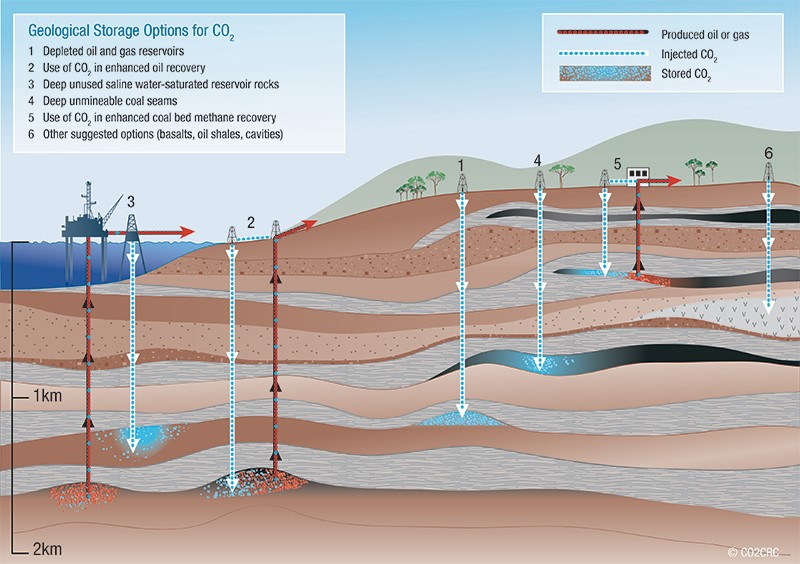What is CCS?
Page last updated:13 October 2021
Carbon capture and storage (CCS), sometimes referred to as carbon capture, utilisation and storage (CCUS), takes carbon dioxide (CO2) captured from the burning of fossil fuels and other sources (such as from cement production, steel manufacture), and injects it deep underground into the tiny pore spaces present between grains in sedimentary rocks (such as sandstones). Typically, depths of storage are around 2 km underground.
CO2. CO2 is a greenhouse gas that occurs naturally and is also emitted as a result of human activities such as burning fossil fuels, agriculture, and other industries (this is called anthropogenic CO2, that is, CO2 emitted as a result of human activity). CO2 can be captured and injected deep underground for permanent storage. Natural CO2 accumulations in the subsurface and natural gas fields provide good examples of how CO2 can be permanently trapped underground. We can observe the behaviour of CO2 in various situations (for example, releasing CO2 bubbles from opening a soft drink can), which helps us to understand how CO2 will behave in geological formations. Together with Questacon, the National Science and Technology Centre in Canberra, we used a specialised camera that allows us to image CO2 to record some basic experiments and everyday uses of CO2.
Capture. CO2 is captured from stationary emissions sources such as power stations, natural gas production, fossil fuel hydrogen production and industrial facilities such as steel or cement manufacturing plants. Research is underway to develop methods to cheaply and efficiently extract CO2 directly from the air to generate new products or for geological storage (direct air capture and storage, or DACS).
Transport. CO2 can be transported from the emission source to the storage location via pipelines, ships, by road (truck) or rail, much like natural gas.
Injection and storage. At the storage location, CO2 is injected deep underground into a suitable geological formation for permanent storage, such as saline aquifers (e.g. sandstones that are filled with brine), depleted oil or gas fields, and potentially in other types of rocks such as deep coal seams or basalts. Within the reservoir rock, CO2 is initially trapped within the pore spaces between grains and prevented from moving out of the formation by overlying impermeable rocks (seals). Over time, the CO2 dissolves into the formation water, eventually reacting to form new minerals.
Utilisation. Some of the captured CO2 can be used to make other products. For example, CO2 may be injected underground to enhance oil recovery in mature oil fields or used to create new products, such as fertilisers, fuel or food products. At the moment, most of the CO2 that is used by industry is supplied from naturally occurring geological accumulations of CO2. Captured anthropogenic CO2 could replace some of these natural sources.
Monitoring, mitigation and verification (MMV) of CO2 in the subsurface is a critical part of the CCS process and usually mandated through regulations and legislation. The purpose of MMV is to make sure that the injected CO2 is safely and permanently stored. Monitoring techniques can include time-lapse seismic, a variety of down-hole sensors, fluid and soil gas analysis, near surface measurements of atmospheric CO2 concentration, and even aerial or satellite imaging.
